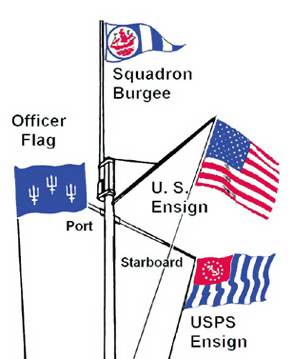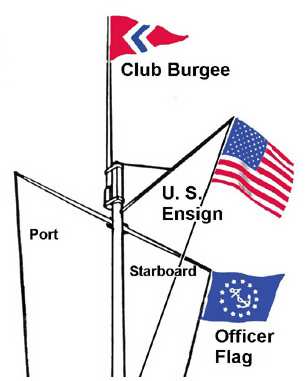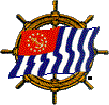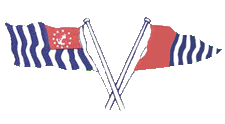 |
|
|
|---|---|---|
Flag and Etiquette
|
Do It Right! |
|
|
|
||
How to Fly Flags, Nautical Flag Display
Errata Information for the 1998 edition(as of 1 Sep 04)
While How to Fly Flags, Nautical Flag Display booklet is probably the best resource on nautical flag display available to the recreational boater, some areas needing clarification were discovered after the booklet was first published. The purpose of this errata information page is to provide updated information to the reader.
Page 1
Throughout Section 1, the words points of display should be used instead of points of honor when referring to locations that the national ensign is not flown from. Points of honor refer only to the locations that the a national ensign is flown.
In paragraph two, the order of preference follows from the highest organization with which you are associated with regardless of whether or not you bear allegiance to the organization.
Page 2
In the listing of points of display, the fourth bulleted item should read, "spreaders/yardarms (starboard superior to port)" and the last bulleted item should be removed.
The point of honor on your boat is always reserved for the national ensign of the vessel's registry or any other flag authorized to be worn in its stead (e.g., the U.S. yacht ensign or the USPS ensign.)
Page 3
The national ensign is only flown from the peak of the gaff while underway. When not underway, it should be flown from the flagstaff at the boat's stern.
Page 4
Flying the national ensign from the peak of the aftermost gaff is an alternative to using a stern staff. Also as an alternative to the stern staff, Marconi-rigged vessels may display the ensign high on the back stay, no higher than two-thirds the distance up its length. Although rarely seen today, traditionalists may continue the practice of attaching the ensign to the leach of the aftermost sail.
Page 8
Note that association flags are of lesser dignity than yacht club or squadron burgees.
Page 10
Cruise or Rendezvous pennants
Some yachting organizations have adopted a distinctive pennant to be displayed by participants in certain special events. These may be specific to the event or may be universal and not directed to any such event. USPS has for example, adopted a cruise pennant which was first employed at is 1985 national cruise. This pennant has the same dimensions as the OIC pennant.
![]()
USPS Cruise Pennant
Page 13
The guest flag should be worn on the starboard main spreader unless that position is occupied by a courtesy flag or other flag of superior dignity.
Page 14
Navigation Rules provide that a vessel restricted in ability to maneuver due to diving is to display a rigid replica not less than 1 meter (about 40 inches) high of the International Code flag A (Alpha).
Page 17
On Memorial Day, the national ensign is properly flown at half-staff until 1200 and then raised to the truck.
Page 19
The 'K', 'E', and '3' code flags were omitted from the suggested list of code flags to be used when dressing ship.
 1 |
|
 G |
Add the 3 missing signal flags between the '1' and 'G' flags.
Page 21
The U.S. ensign is not depicted flying correctly from the peak of the gaff. It should be depicted as follows:

Page 23
The U.S. ensign is not depicted flying correctly from the peak of the gaff. It should be depicted as follows:

Glossary
The following new terms have been defined:
|
bend on
|
v. To attach a flag to a halyard.
|
|
boat
|
n. 1. Any vessel capable of being hoisted aboard another vessel.
n. 2. A submarine. |
|
bow
|
n. The front of a vessel.
|
|
dipping
|
v. The custom of briefly lowering a flag as a salute to another vessel.
|
|
dress ship
|
v. To decorate a vessel with the flags of the International Code of Signals.
|
|
field
|
n. The background color or pattern of a flag.
|
|
finial
|
n. The ornament affixed to the top of a flag staff.
|
|
house flag
|
n. The distinguishing flag of the commercial or private owner of a vessel. Among yachts, it is traditionally tapered swallowtail in shape.
|
|
jack
|
n. A small flag flown under certain circumstances at the bow of a vessel, usually a warship. The U.S. "union jack" is a replica of the canton of the national flag being worn. (In Great Britain, the national flag is called the "union jack")
|
|
officer flag
|
n. A unique flag emblematic of a specific office. USCGAux practice refers to these a as "pennants" for active officers and "burgees" for past officers. Note that the term officer's flag (burgee, pennant) is a possessive and refers to any flag belonging to an officer.
|
|
port
|
n. The left side of a vessel.
|
|
secure
|
v. To remove a flag from display.
|
|
spar
|
n. A mast, boom, yardarm used in a sailboat's rigging.
|
|
staff
|
n. A pole on which a flag is worn.
|
|
starboard
|
n. The right side of a vessel.
|
|
stern
|
n. The rear of a vessel.
|
|
vexillology
|
n. The authoritative study of the history, symbolism and usage of flags. [VEXILLOLOGIST VEXILLOGICAL]
|
The definitions of the following terms have been updated:
|
pennant
|
n. Generally regarded as a triangular flag such as a club burgee. In some organizations, (e.g., the USCGAux) the term may be more specific.
|
|
regatta
|
n. An assembly of craft participating in an organized event such as a race, parade or predicted log contest.
|
|
swallowtail
|
adj. The shape of a flag which has a triangular "notch" in its trailing edge. The flag may be tapered, i.e., the width diminished with its length.
|
|
truck
|
n. A fitting at the top of a mast embodying sheaves (pulleys) through which halyards are passed. Also used to mean the top of the mast.
|
|
two-blocked
|
n. To raise a flag to its maximum height. A national ensign should pass through the two-blocked position when raised to, and lowered from, a half-masted position.
|
|
wear
|
v. To display a flag (as a ship does.) Vessels wear flags. People fly flags on their vessels.
|
|
yardarm, yard
|
n. A Horizontal spar from which square-rigged sails are hung. The crossarm of a signal mast. Technically, the spar is a "yard;" the ends are the "yardarm."
|

|
|



